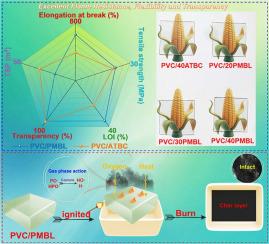以l -乳酸为原料制备可生物降解的含磷阻燃增塑剂,以同时提高柔性聚氯乙烯的韧性、阻燃性和透明度
IF 7.4
2区 化学
Q1 POLYMER SCIENCE
引用次数: 0
摘要
生物基增塑剂已经成为解决传统聚合物中石油衍生添加剂的环境问题和性能限制的一种有前途的解决方案。然而,对于单一功能的增塑剂(无论是石油基的还是生物基的),固有的可燃性是一个共同的特征。当这些增塑剂应用于柔性聚氯乙烯(PVC)时,它们往往会严重损害PVC基体的固有阻燃性能,从而增加了与实际应用相关的潜在火灾危险。因此,一种新型可生物降解的含磷阻燃增塑剂(PMBL)被开发出来,以解决上述挑战,同时具有阻燃和塑化功能。与用于软化聚氯乙烯的普通增塑剂相比,PMBL的加入不仅可以增强柔性PVC共混物的韧性,而且可以保持其优异的阻燃性能。在加入PMBL后,PVC/PMBL共混物达到了UL-94 V-0等级,断裂伸长率从3.9%(纯PVC)大幅增加到647.8% (PVC/40PMBL),这一性能优于与乙酰柠檬酸三丁酯(ATBC)增塑化的PVC共混物。锥形量热计测试结果显示,与PVC/40ATBC相比,PVC/40PMBL的峰值放热率降低了61%,总放热率降低了56%,这表明PMBL有效地抑制了柔性PVC共混物的放热。此外,PMBL表现出优异的抗迁移和抗挥发性,从而使柔性PVC产品保持较长的使用寿命和稳定性。土壤降解试验证实PMBL具有良好的生物降解性。总之,本研究有望为开发功能性生物基添加剂提供一个可行的策略。本文章由计算机程序翻译,如有差异,请以英文原文为准。

Fabrication of biodegradable phosphorus-containing flame-retardant plasticizer derived from L-lactic acid toward simultaneously enhancing the toughness, flame retardancy and transparency of flexible polyvinyl chloride
Bio-based plasticizers have emerged as a promising solution for addressing environmental concerns and performance limitations associated with traditional petroleum-derived additives in polymers. However, for plasticizers (whether petroleum-based or bio-based) with single functionality, inherent flammability is a common characteristic. When such plasticizers are applied in flexible polyvinyl chloride (PVC), they tend to significantly impair the intrinsic flame-retardant performance of PVC matrices, thereby elevating the potential fire hazards associated with their practical application. Therefore, a novel biodegradable phosphorus-containing flame-retardant plasticizer derived from l-lactic acid (PMBL) was developed to address the aforementioned challenge, with integration of both flame-retardant and plasticizing functionalities. Compared with the common plasticizers used to soften polyvinyl chloride, the addition of PMBL can not only enhance the toughness of flexible PVC blends, but also retain their excellent flame-retardant properties. Upon the incorporation of PMBL, PVC/PMBL blends attained a UL-94 V-0 classification, and exhibited a substantial increase in elongation at break from 3.9 % (for pure PVC) to 647.8 % (for PVC/40PMBL), a performance that outperformed PVC blends plasticized with acetyl tributyl citrate (ATBC). Cone calorimeter test results revealed that PVC/40PMBL, in comparison to PVC/40ATBC, exhibited a 61 % reduction in peak heat release rate and a 56 % decrease in total heat release, findings that indicate the effective suppression of heat release from flexible PVC blends by PMBL. Furthermore, PMBL exhibited excellent resistance to migration and volatility, thereby enabling flexible PVC products to maintain prolonged service life and stability. Soil degradation tests confirmed good biodegradability of PMBL. Overall, this study is anticipated to offer a viable strategy for developing functional bio-based additives.
求助全文
通过发布文献求助,成功后即可免费获取论文全文。
去求助
来源期刊

Polymer Degradation and Stability
化学-高分子科学
CiteScore
10.10
自引率
10.20%
发文量
325
审稿时长
23 days
期刊介绍:
Polymer Degradation and Stability deals with the degradation reactions and their control which are a major preoccupation of practitioners of the many and diverse aspects of modern polymer technology.
Deteriorative reactions occur during processing, when polymers are subjected to heat, oxygen and mechanical stress, and during the useful life of the materials when oxygen and sunlight are the most important degradative agencies. In more specialised applications, degradation may be induced by high energy radiation, ozone, atmospheric pollutants, mechanical stress, biological action, hydrolysis and many other influences. The mechanisms of these reactions and stabilisation processes must be understood if the technology and application of polymers are to continue to advance. The reporting of investigations of this kind is therefore a major function of this journal.
However there are also new developments in polymer technology in which degradation processes find positive applications. For example, photodegradable plastics are now available, the recycling of polymeric products will become increasingly important, degradation and combustion studies are involved in the definition of the fire hazards which are associated with polymeric materials and the microelectronics industry is vitally dependent upon polymer degradation in the manufacture of its circuitry. Polymer properties may also be improved by processes like curing and grafting, the chemistry of which can be closely related to that which causes physical deterioration in other circumstances.
 求助内容:
求助内容: 应助结果提醒方式:
应助结果提醒方式:


